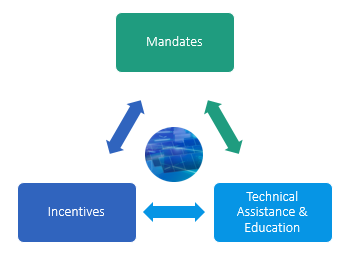Aligning Local Building Ordinances and CCA Programs for Climate Action

When addressing climate change, integrated planning that connects local needs with emerging energy opportunities is needed to achieve resilient, equitable results. In the past, California’s major investor-owned utilities have dominated the discussions, but today, community choice aggregation (CCA) programs across the state are rising to dominate as energy providers allowing for a bottom-up approach to energy planning.
Now that CCAs are well established, local governments are better positioned to coordinate with their CCA to design and implement complimentary policies and energy programs that address climate action plans and other agenda items. By aligning efforts, CCAs can better respond to community-level concerns and take full advantage of available distributed energy resources. Many opportunities exist for CCAs to work closely with local government partners to take control of energy decisions and maximize the impact of their respective initiatives, such as aligning building ordinances with energy-saving programs.
Identifying alignment
The CCA model of local decision-making enables communities to prioritize needs, align with local goals, better coordinate local businesses and stakeholders, and target programs to their community. However, operationalizing these benefits requires close coordination between entities. A helpful first step in the planning process is mapping out areas of authority to identify potential alignment. Local governments have historically had jurisdiction over land-use planning efforts, permitting and zoning, while CCAs are now responsible for energy procurement and rate setting, among other things. Similarly, both entities develop planning documents (e.g., general plans, climate action plans, implementation plans) that can be used to inform energy program development and tie efforts to shared goals identified within these plans.

For example, the City of San Diego General Plan adopted a policy to “create and apply incentive zoning measures to achieve the desired mix of land uses and public benefits,” which could be implemented to promote local clean energy projects. In Alameda County, East Bay Community Energy’s Local Development Business Plan provides a framework for developing clean energy projects that benefit the community and helps inform local government agencies about needs and any existing barriers. Identifying alignment and tying initiatives and programs to stated goals in various plans will ensure these efforts keep the community on track to achieve their goals, as well as provide political justification for new investments and use of other public resources.
Opportunities to promote synergism
Once aligned on goals, close coordination between local government agencies and CCAs will help ensure their respective policies and initiatives work together to meet shared goals, such as greenhouse gas emissions reductions or development of economically sound local energy efficiency programs. The relationship between code mandates, incentives, technical assistance and education will result in synergies wherein CCA programs can support local initiatives and local governments can leverage An example of this relationship is how local government authority over building codes and ordinances can work hand-in-hand with CCA programs to support a variety of clean energy initiatives. their authority to support CCA program goals.

Mandates
A common first step for cities is mandating building energy use reporting through benchmarking ordinances. This is a strategic policy for gathering data at the building level that can help inform program design and needs, while also establishing a relationship with the building owner community for program enrollment. In addition, energy benchmarking may incent greater participation in energy efficiency or other demand management programs as building energy use is made more visible. A report by the Lawrence Berkeley National Laboratory demonstrated a 2% to 14% reduction in energy use when benchmarking and transparency policies are implemented.
In addition, local reach codes that go beyond minimum state requirements for energy use can be enacted to support energy programs and initiatives. For example, requiring more advanced building automation systems or other interactive grid technologies will enable greater participation in CCA demand response programs. Similarly, electric vehicle (EV) charging infrastructure mandates within building code lay the foundation for clean transportation initiatives by CCAs. Lastly, while establishing reach codes or local ordinances, cities should consider establishing long term goals to help inform market transformation program needs that could be addressed through CCA programs.
Incentives
While mandates help lay the foundation for electrification and energy programs, incentives are essential for easing the implementation of new mandates and triggering market transformation, and CCAs can design programs with these objectives in mind. As CSE helped the City of Carlsbad develop its reach codes, it was evident that incentives for early adopters can help gain support for new requirements and ease their adoption. While this reach code was developed without a CCA in the region, the lessons are relevant as CCAs consider how incentives for technologies such as heat pumps can help gain support for future reach codes that may favor electrification. For example, in Carlsbad, solar photovoltaic (PV) incentives were factored into the cost-effectiveness analysis necessary for reach code development and the availability of these incentives was an important discussion point when conducting stakeholder outreach. The experience also further demonstrated the importance of close coordination between code development and program design as some existing incentives were impacted by new regulations.
Incentive programs can also increase the value proposition of building code requirements. For example, incentives for purchasing EVs or smart charging equipment may make stakeholders more amenable to EV charging infrastructure mandates within building codes, similar to how demand management programs can help justify requirements for advanced energy controls and address new load demands from electrification. In addition, programs can target those customers most impacted by new ordinances to ease implementation and address potential barriers for future customer expansion of requirements.
Technical assistance & education
The third component to consider is how CCA programs can support the successful implementation of building ordinances through education and technical assistance. Such support reduces the burden on stakeholders and customers by helping them understand requirements and by providing expert resources.
For example, CSE operates the San Diego Regional Benchmarking Coach program that gives building owners and operators one-on-one support as well as in-person and online workshops to help them benchmark their energy use and comply with state and city reporting requirements. We provided similar support for the City of Chula Vista’s Code Coach program, which focused on educating local building officials. Such training is essential for ensuring compliance with new regulations to meet goals and help make inspection processes more efficient, which reduces soft costs for developers and consumers. While these programs historically have been funded through investor-owned utilities, many of these budgets are anticipated to shrink, creating an opportunity for CCAs to use similar tactics to support local governments in implementing new codes and ordinances. Such assistance and education helps ensure successful program implementation and can garner support for further local policies and reach codes that bring communities closer to meeting their climate action plan goals.
Coordinating resources
There are many areas of alignment for local governments and CCAs to explore and coordinate their respective authority and resources as they continue to develop local programs to maximize the impacts of climate initiatives.
- Leveraging general plans to identify promising locations for local energy projects
- Designing rate tariffs that meet local priorities
- Implementing programs specific to public facilities and fleets
- Helping local governments reduce soft costs for projects through technical support and streamlined permitting
Overall, coordination of various local government regulations and responsibilities with CCA procurement, rates and energy programs is best served by early alignment, long-term planning and robust resource and data sharing that will help achieve the greatest results for their communities.

